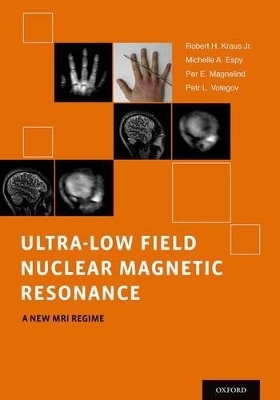
Ultra-Low Field Nuclear Magnetic Resonance
Oxford University Press Inc (Verlag)
978-0-19-979643-4 (ISBN)
This book is designed to introduce the reader to the field of NMR/MRI at very low magnetic fields, from milli-Tesla to micro-Tesla, the ultra-low field (ULF) regime. The book is focused on applications to imaging the human brain, and hardware methods primarily based upon pre-polarization methods and SQUID-based detection. The goal of the text is to provide insight and tools for the reader to better understand what applications are best served by ULF NMR/MRI approaches. A discussion of the hardware challenges, such as shielding, operation of SQUID sensors in a dynamic field environment, and pulsed magnetic field generation are presented. One goal of the text is to provide the reader a framework of understanding the approaches to estimation and mitigation of low signal-to-noise and long imaging time, which are the main challenges. Special attention is paid to the combination of MEG and ULF MRI, and the benefits and challenges presented by trying to accomplish both with the same hardware. The book discusses the origin of unique relaxation contrast at ULF, and special considerations for image artifacts and how to correct them (i.e. concomitant gradients, ghost artifacts). A general discussion of MRI, with special consideration to the challenges of imaging at ULF and unique opportunities in pulse sequences, is presented. The book also presents an overview of some of the primary applications of ULF NMR/MRI being pursued.
The authors are or have recently been members of the Los Alamos "SQUID Team" that pioneered a variety of Ultra-Low Field MRI applications including ULF MRI in conjunction with MEG (magnetoencephalography) for concurrent imaging of anatomy and function in the human brain, and ULF Relaxometry used to detect dangerous substances in security screenings.
Table of Contents ; Foreword by John Clarke ; Preface ; Acknowledgments ; Common Acronyms and Abbreviations ; Common Constants and Conversions ; 1. Fundamental Principles of NMR and MRI at ULF ; 1.1. Introduction ; 1.2. Characteristics of NMR Signal ; 1.3. Introducing Signal-to-Noise and Contrast-to-Noise ; 1.4. NMR and MRI at Ultra-Low Fields ; 1.5. MRI Effects ; 1.6. New Regimes of Physics Accesible at Ultra-Low Field ; 1.7. Summary of MRI and ULF ; 1.8. Summary of HF and ULF MRI Comparisons ; 2. Nuts and Bolts of ULF MRI ; 2.1. Introduction ; 2.2. General Concepts of Pre-Polarization Field Generation ; 2.3. Generation of Measurement Field, Gradients, and Spin-flip ; 2.4. Sensing the ULF-MR Signals ; 2.5. Magnetic Shielding ; 3. Magnetic Resonance Phenomena at ULF ; 3.1. Interaction between the Electromagnetic Radiation and the Nuclear Spins at ULF ; 3.2. Quantum Mechanical Description of Interaction between the Electromagnetic Radiation and the Nuclear Spins ; 3.3. Theory of Relaxometry (Focused on Magnetic Field Dependence) ; 4. Imaging Techniques at ULF ; 4.1. Introduction ; 4.2. General Imaging Concepts (How to do MRI) ; 4.3. ULF MRI ; 4.4. Imaging Techniques: Making the Most of What You Got ; 4.5. On the Plus Side ; 4.6. Conclusions ; 5. Applications in ULF MRI ; 5.1. Multi-modal imaging of human brain anatomy and function: MEG and ULF MRI ; 5.2. New approaches to image human brain function uniquely enabled by ULF MRI ; 5.3. MagViz and ULF NMR relaxometers ; 5.4. A Final Word ; Disclosures ; Index
| Erscheint lt. Verlag | 15.5.2014 |
|---|---|
| Zusatzinfo | 96 illustrations |
| Verlagsort | New York |
| Sprache | englisch |
| Maße | 254 x 178 mm |
| Gewicht | 816 g |
| Themenwelt | Medizin / Pharmazie ► Medizinische Fachgebiete ► Neurologie |
| Medizinische Fachgebiete ► Radiologie / Bildgebende Verfahren ► Kernspintomographie (MRT) | |
| Naturwissenschaften ► Biologie ► Zoologie | |
| Naturwissenschaften ► Chemie ► Analytische Chemie | |
| Technik | |
| ISBN-10 | 0-19-979643-2 / 0199796432 |
| ISBN-13 | 978-0-19-979643-4 / 9780199796434 |
| Zustand | Neuware |
| Haben Sie eine Frage zum Produkt? |
aus dem Bereich


